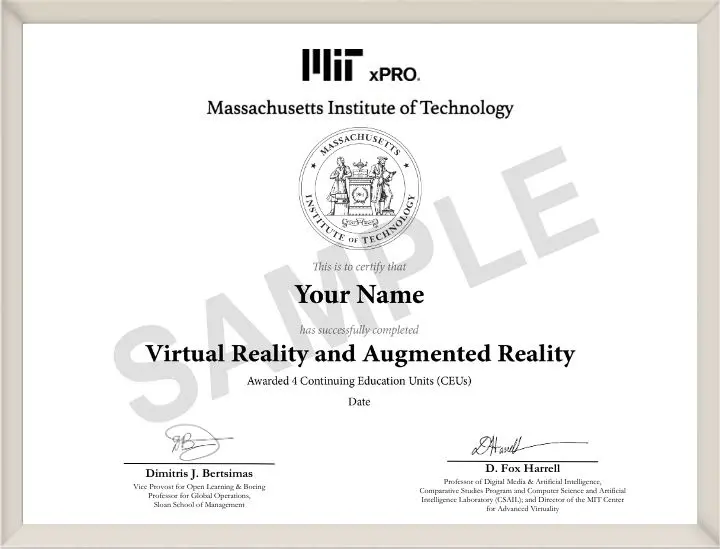Virtual Reality and Augmented Reality
Be The Pioneer: Immerse Yourself in the Fundamentals of Augmented Reality (AR), Virtual Reality (VR), and Mixed Reality (MR)
The benefits associated with XR technologies for industry and for society are too great to ignore. Imagination and technology combine to create mixed reality experiences that change the way we communicate, learn, play, and work. Over the next decade, every industry will adopt aspects from this suite of immersive technologies — notably retail/ecommerce, education, IT, entertainment, manufacturing, and healthcare. Now it’s your turn.
The Virtual Reality and Augmented Reality program from MIT xPRO provides a foundational understanding and conversational fluency in the principles of XR technologies, an umbrella term that includes AR, VR, and MR. Over the course of eight weeks, you will:
Acquire the essential vocabulary and knowledge of XR concepts to communicate meaningfully with different stakeholders.
Gain introductory practical experience with XR system development and better understand how to generate XR system development ideas and communicate with developers.
Expand your knowledge of XR system elements, including design principles, approaches, and processes, taking into account users’ needs and values.
Apply XR concepts and design principles to create a high-fidelity XR prototype.
Ensure your technologies are inclusive and designed to promote social good.
Explore the broader implications of XR technologies, including the new opportunities they provide, enabling you to make recommendations to stakeholders, clients, and other key audiences.
Drawing on faculty expertise, case studies, and peer interactions, you will develop a deeper understanding of XR system elements, including design principles, approaches, and processes, learning to consider users’ needs and values in XR design to create XR prototypes.
Who Is This Program For?
This eight-week program is ideal for seasoned professionals who want to expand their capabilities and explore the rapidly growing field of XR technologies.
Design Professionals: UX, UI, and XR designers seeking to expand their capabilities to include a technical understanding of how to integrate visual design elements, user needs, values, and considerations of social impact into the design and development of XR systems for their organization or client.
Developers: Unity developers, app developers, and 3D developers focused on VR/AR apps and experiences seeking to expand their technical knowledge of XR technologies and understand their wide range of practical applications and unique development requirements.
Technology Adopters: Professionals who are interested in the application of XR technologies to improve the customer experience and/or to reduce costs, time to market, and learning curves.
Prior knowledge of Unity, C++, and C# programming languages are helpful, but not mandatory.
*Participants must be 18 or above to apply for this program.
Key Takeaways
Over the course of this eight-week program, you will learn the principles of designing effective and engaging XR experiences that are inclusive and promote social good. Specifically, you will:
Acquire the essential vocabulary and knowledge of XR concepts to communicate meaningfully with different stakeholders.
Gain introductory and practical experience with XR system development to better understand how to generate XR system development ideas and communicate with developers.
Expand your knowledge of XR system elements, including design principles, approaches, and processes, considering user needs and values.
Apply XR concepts and design principles to create a high-fidelity XR prototype.
Ensure that your technologies are inclusive and designed to promote social good.
Explore the broader implications of XR technologies, including the new opportunities they provide, to make recommendations to stakeholders, clients, and other key audiences.
Program Topics
Program Highlights
Explore applications for different immersive technologies with an industry thought leader, MIT Professor and Director of the MIT Center for Advanced Virtuality, D. Fox Harrell.
Get access to exclusive interviews with industry pioneers in digital storytelling, UX design, multimedia art, and product innovation.
Gain practical experience by defining, visualizing, and pitching your XR game concept, punctuated by building a prototype.
Learn to apply the principles of AR and VR with Unity and Qlone.
Accelerate your professional development through personalized feedback, active support, and network development.
Participate in live weekly office hours with learning facilitators.
Earn a verified digital certificate and four Continuing Education Units (CEUs) from MIT xPRO.
System and Applications Requirements
To experience VR apps, you will need to purchase a VR headset, such as a Merge VR Headset or Google Cardboard VR Headset (compatible with most iOS and Android smartphones. Preferred; phones from 123mm to 156mm).
To experience VR/AR apps, your mobile phone must have an iPhone Operating System 11 or latest (iOS) or Android Operating System (OS) Oreo or latest; with a camera.
Other headsets that may be used to experience VR/AR include HTC Vive, Oculus Go, Meta Quest, Sony PlayStation VR, and BOBOVR.
In addition, as you progress through the program, you will need to install trial and/or free software required for making XR components, such as Unity Personal and Qlone. For example, to view the 360-degree prototypes you will make in Module 3, you will need to download the VR Media Player for Android or the VR Player for iPhone users.
System Requirements
To successfully complete this program online, you must have access to a computer with the following minimum requirements.
Windows/PC Minimum System Requirements
Processor: Intel i3-6100 / AMD Ryzen 3 1200, FX4350 or greater (recommended: Intel i5-4590/ AMD Ryzen 5 1500X or greater)
CPU: SSE2 instruction set support
RAM: 16GB or greater
GPU: graphics card with DirectX 11 or DirectX 12 and Shader Model 5.0
Disk Space: minimum 75GB free space, preferably SSD storage
Computer: Windows 10 machine (See the Mac notice below)
Preferred browser: Chrome, Firefox (in this order)
Mac Minimum System Requirements
The minimum requirements for Mac users include:
OS: 10.13+
CPU: X64 architecture with SSE2 instruction set support
RAM: 16GB or greater
Graphics API: Metal-capable Intel and AMD GPUs
Disk Space: Minimum 75GB free space, preferably SSD storage
Apple officially supported drivers.
Preferred browser: Chrome, Firefox (in this order)
Whether you are a Windows or Mac user, the following requirements apply:
High-speed internet connection with a connection speed of 1.5 MB/s or better
Preferred devices: laptop, desktop, or mobile device of any make and operating systems mentioned above with webcam and microphone
Refer to the
Unity Manual for system requirements (https://docs.unity3d.com/Manual/system-requirements.html) for more detailed information onusing the Unity editor.
Program Faculty

Professor of Digital Media & Artificial Intelligence, Comparative Studies Program and Computer Science and Artificial Intelligence Laboratory (CSAIL); Director of the MIT Center for Advanced Virtuality
Professor D. Fox Harrell’s research focuses on pioneering new forms of computational media, such as interactive narrative technologies, virtual and augmented reality systems, ...
Guest Speakers

Co-Founder and Producer, Atlas V
Antoine is a French producer with 15 years of experience creating immersive works, transmedia documentaries, short films, music videos, and high-end commercials. His company s...

Director of Product and Innovation at Arrow Electronics | Digital SaaS; Research Affiliate at MIT
An inventor, engineer, and entrepreneur at heart, Vik desires to positively change how we interact using technology. He leads engineering teams through the full product journe...

Former Head of Digital Experiences, wow
Allison Crank is a UX designer and researcher exploring the intersection of art, technology, and architecture. Currently, she works as a freelance UX designer for video games ...

Documentary Media Artist and Fulbright Research Fellow, Seoul Institute of the Arts
Andrea is an interdisciplinary researcher and multimedia artist based in Los Angeles. Her work explores avatar embodiment, virtual idols, and cultural theory, with a focus on ...
Featured Learner Testimonials
About MIT xPRO
MIT xPRO's online learning programs leverage vetted content from world-renowned experts to make learning accessible anytime, anywhere. Designed using cutting-edge research in the neuroscience of learning, MIT xPRO programs are helping professionals build their skills on the job. To explore the full catalog of MIT xPRO courses and programs, visit xpro.mit.edu.
About the MIT Center for Advanced Virtuality
The MIT Center for Advanced Virtuality pioneers innovative experiences using technologies of virtuality. Such technologies, ranging from Virtual Reality (VR) to Cinematic Reality (CR) and beyond, all use computing to construct imaginative experiences that overlay our physical world. It is important to create and deploy such technologies effectively as they are now used every day to communicate, express, learn, play, and work. Professor Harrell is Director of the Center for Advanced Virtuality and faculty director of the MIT Center for Advanced Virtuality.

Certificate
Get recognized. Upon successful completion of this program, MIT xPRO grants a certificate of completion to participants and four Continuing Education Units (CEUs). This program is graded as a pass or fail; participants must receive 75% to pass and obtain the certificate of completion.
Note: After successful completion of the program, your verified digital certificate will be emailed, at no additional cost, in the name you used when registering for the program. All certificate images are for illustrative purposes only and may be subject to change at the discretion of MIT.
FAQs
Financing Options
Climb Credit*
We offer financing options with our partner, Climb Credit*. Click here to learn more.
*Applicable for US Residents
Flexible Payment Options For All
Flexible payment options allow you to pay the program fee in installments. Click here to see payment schedule.
Have Questions?
Email: enterprise.clientsuccess@emeritus.org. We attempt to respond to queries in 24 hours or less. However, over weekends and holidays, our responses may take up to 72 hours.
